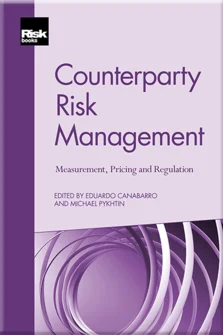Re-Thinking CVA: Valuations, Counterparty Credit Risk and Model Risk
Dan Rosen and David Saunders
The Basel III Enhancements to Counterparty Risk Capital Charges
The Regulation of Counterparty Risk in Over-the-Counter Derivatives Markets
The Non-Internal Model Method for Counterparty Credit Risk
On Credit Valuation Adjustments and Regulatory Capital
American Monte Carlo: A Practitioner Approach
Best Market Practice for Calculation and Reporting of Wrong-Way Risk
Central Counterparty Risk
CVA Risk Management Post-Crisis
Re-Thinking CVA: Valuations, Counterparty Credit Risk and Model Risk
Should Derivatives Dealers Make A Funding Value Adjustment?
Adjoint Algorithmic Differentiation: Real-Time Counterparty Credit Risk Management in Monte Carlo Simulations
Stress Test of Counterparty Risks and Dynamic Hedging of the CVA
Dynamic Stress Testing of Counterparty Default Risk
Collateral: Modelling, Pricing and Optimisation

The market price of over-the-counter (OTC) derivatives must reflect the credit risks faced by the counterparties. The credit value adjustment (CVA) is the market price of this counterparty credit risk. Some large banks began calculating CVAs in the early 1990s (Sorensen and Bollier 1994). Prior to the 2007–9 global financial crisis, CVA was generally ignored or too small to be noticed by most players, and mark-to-market losses due to CVA were not directly capitalised. However, CVA is now an essential part of derivatives business best practices, accounting standards and Basel III regulation (see, for example, Financial Accounting Standards Board 2006; Basel Committee on Banking Supervision 2010).
There is nothing simple about CVA in practice. Going from textbook exercises to the practical implementation is not straightforward: the definition is itself complex; models and calculations are involved; managing the resulting market and credit risks is difficult; and data will always be incomplete. Understanding the significance and impact of model risk is critically important when considering issues of valuation, hedging and risk measurement surrounding CVA.
CVA is pricing. But do
Copyright Infopro Digital Limited. All rights reserved.
As outlined in our terms and conditions, https://www.infopro-digital.com/terms-and-conditions/subscriptions/ (point 2.4), printing is limited to a single copy.
If you would like to purchase additional rights please email info@risk.net
Copyright Infopro Digital Limited. All rights reserved.
You may share this content using our article tools. As outlined in our terms and conditions, https://www.infopro-digital.com/terms-and-conditions/subscriptions/ (clause 2.4), an Authorised User may only make one copy of the materials for their own personal use. You must also comply with the restrictions in clause 2.5.
If you would like to purchase additional rights please email info@risk.net











